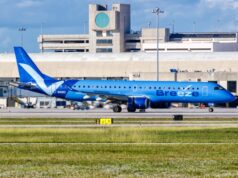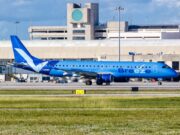
GPS technology is widely used both within and outside aviation contexts. As satellite-based navigation, GPS is capable of providing accurate navigation information for the departure, en route, and terminal segments. Advancements in NextGen (the FAA’s air transportation modernization effort) strive to transition towards RNAV (area navigation) routing, rather than continuing to rely on ground-based navigation systems. The Instrument Rating Airman Certification Standards (ACS) require applicants to possess adequate knowledge of the principles of operation of navigation equipment and systems, including GPS and RNAV technologies.
Within the United States, the system is controlled by the Department of Defense. Principles of operation rely on two concepts: triangulation and pseudo-ranging. Pseudo-ranging is the concept of utilizing speed and time information to derive distance. As the GPS signal is transmitted from the aircraft receiver, a data package is included with a time stamp of the signal emission. Satellites in space are equipped with atomic clocks capable of noting the time of reception. By factoring the signal velocity (speed of light) and time elapsed from emission to reception, distance information is determined. Through triangulation, a minimum of three satellites are required to determine the receiver’s geographical position, while a fourth satellite is needed for altitude information.
With the intent to monitor the accuracy and integrity of GPS, Receiver Autonomous Integrity Monitoring (RAIM) was developed. As a back-up monitoring system, RAIM alerts the pilot of any signal degradation impairing GPS reliability for IFR navigation. Pilots are required to check for RAIM predictability prior to flight, as well as review GPS NOTAMs. GPS NOTAMs are issued by the FAA and contain information regarding RAIM outages across the United States. Depending on the manufacturer, most equipment allow the pilot to predict RAIM directly with a built-in feature. Without RAIM, GPS utilization for IFR navigation is not authorized. A minimum of five satellites are required for RAIM fault-detection capabilities, enabling a faulty satellite to be recognized and identified. Fault detection and exclusion (replacing an unhealthy satellite with an accurate satellite) requires a minimum of six satellites in view.
RAIM failures can occur inflight. Therefore, pilots are required to have a secondary means of navigation onboard other than GPS (except for wide area augmentation system [WAAS] capable receivers). Active monitoring of the backup source, however, is not required. When a RAIM failure occurs, a loss of integrity (LOI) flag indication is displayed. While inflight RAIM failures may not seem critical during the en route phase, they become a challenge when performing RNAV instrument approaches. Guidance for RAIM failures fairly specific per the Aeronautical Information Manual (AIM) and must be carefully followed. GPS receivers conduct a RAIM self-check two nautical miles prior to the final approach waypoint (FAWP). If the test is successful, it will be unknown to the pilot. Yet, the pilot must verify the receiver properly sequences from ARMED to APPROACH prior to the FAWP. If an LOI flag is displayed at any point, the pilot must inform ATC and discontinue the approach. Past the FAWP, the receiver will allow up to five minutes to allow approach completion in the event of a RAIM failure. An LOI annunciation is not common past the FAWP, but, if it does occur, the missed approach should be executed immediately.
Without WAAS, a technology created to enhance GPS accuracy, RNAV approaches are limited to LNAV (lateral navigation) minimums only. LNAV minimums are equivalent to non-precision minimum descent altitudes (MDA). WAAS receivers, on the other hand, are capable of providing vertical guidance, authorizing the usage of LNAV/VNAV (vertical navigation) and LPV (localizer performance with vertical guidance) minima. Both LNAV/VNAV and LPV approaches are flown as precision approaches with decision altitudes, belonging to the APV (approach procedure with vertical guidance) category. Furthermore, pilots operating WAAS-enabled aircraft are not required to have a secondary means of navigation, or even compute RAIM prediction prior to flight.
As NextGen continues to be implemented, the goal is to transition to RNAV technologies and minimize reliance on ground-based navigation due to expensive maintenance costs. GPS has proved its accuracy over the years, being particularly helpful at airports where ground instrument approaches are not available to allow pilots to fly approaches as precise as guidance. Extensive compliance with NOTAMs, as well as a detailed preflight action and compliance with manufacturer limitations, are thereby critical for a successful flight utilizing GPS as a source of navigation.
























































































































“Satellites in space are equipped with atomic clocks capable of noting the time of reception.” This is factually incorrect, although really otherwise a fine article.
The atomic clocks in the satellites generate the time reference. The receivers in use (air, ground, and sea) decode the transmitted time reference from the satellites.
The satellites do not listen to anything with the exception of the ground-based control network.